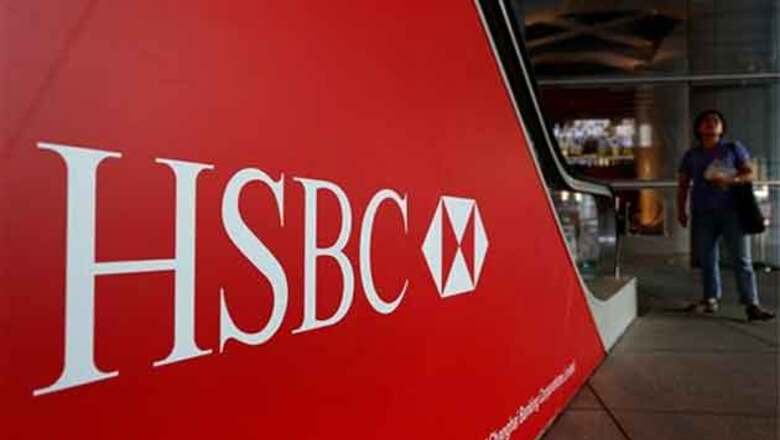
views
London: HSBC will redouble cost-cutting efforts, including axing up to 14,000 more jobs, but Europe's largest bank was forced to soften a key performance target in the face of muted revenue. London-headquartered HSBC is seeking up to $3 billion in additional annual savings by 2016, on top of $4 billion already achieved, but sluggish growth outside Asia, particularly in Europe, means its target to get costs below 52 per cent of revenue has been eased.
The new goal is to keep the ratio near 55 per cent, the level it was at in 2010 - the year before Chief Executive Stuart Gulliver took over and kickstarted a radical retrenchment at a bank that was criticised in the past for "planting flags" around the world. "We're clearly hitting on the costs, but we're missing on the cost efficiency ratio because of revenue, which is hard for us to control," Gulliver told reporters.
"Top line growth is clearly a challenge."He added: "We need to have a cost-efficiency target that's realistic, so we're saying take a look at our peer group, they are all in the high 50s or low 60s, whether it's JPMorgan , Citi , Standard Chartered or Barclays .
"HSBC had a cost efficiency ratio of 63 per cent last year, which improved to 53 percent in the first quarter. Banks do not release comparable data, but last year JPMorgan's expenses were 67 per cent of revenue, at Citi it was 65 per cent, Barclays had an adjusted cost/income ratio of 64 percent and Standard Chartered's normalised cost/income ratio was 54 per cent.
Gulliver, former head of HSBC's investment bank, has already cut 46,000 jobs and sold or closed 52 businesses, including a minority stake in Chinese insurer Ping An and its US credit cards. Such deals have reduced its risk-weighted assets by $95 billion and produced gains totalling about $8 billion."We're not even halfway through unlocking the value in HSBC. The strategy is not changing, it is working," Gulliver told analysts.
Gulliver said the run-off of its US loan book and legacy investment bank assets would make it difficult for HSBC to meet its goal of a return on equity of over 12 per cent this year, but he stuck with that target for the future. He also hardened his goal on capital, aiming for a core capital ratio of more than 10 per cent. HSBC said it would "progressively grow" its dividends and would introduce a share buyback next year, if investors and regulators give their approval. That would make it one of the first European banks to buy back shares since the financial crisis. Its aim would be to offset the impact of its scrip or share dividend, which is popular with Hong Kong retail investors but causes dilution for shareholders as more than $2 billion of shares are issued each year.
"They are doing a good job on costs, capital looks good, balance sheet looks good, but the big issue is when does the revenue growth come through?" said Chris Wheeler, analyst with Mediobanca. "The big debate will rage about revenue growth. "Shares in HSBC, the world's third-largest by stock market value after China's ICBC and China Construction Bank , were up 0.9 per cent at 753 pence by 1230 GMT against a 1.6 per cent rise in the European sector.The stock has risen around 13 per cent since the start of 2011, compared with a 9 per cent drop in the sector.
In the face of weak demand in Europe, HSBC plans to increase revenue by focusing on high-return markets in Asia, where it generated around two-thirds of its profit in the first quarter.It has scaled back its annual revenue growth targets for its wealth management division by $1 billion to an additional $3 billion, blaming tougher regulations for crimping its ability to sell products in countries such as Britain.Gulliver said the bank was unlikely to spend extra cash on any significant acquisition. He said the bank could also sell its 8 per cent stake in Bank of Shanghai, which he said was likely to be worth between $500 million and $600 million. Its 19 per cent stake in Bank of Communications remain core and was it key China associate, he said.
The bank said this week it could sell its private banking business in Monaco, but its new cost-cutting campaign is set to focus less on disposals and outright closures and more on streamlining processes. The bank said employee numbers could fall to between 240,000 and 250,000 by 2016, from 254,000 when current disposals and announced cuts take effect. It did not say where the additional cuts would be made, saying only they would be "spread quite thinly around the world". With the banking industry assailed by a new world order of tougher regulation and weak investment returns, HSBC said it needed to take its cue from other sectors that faced major challenges including telecoms and car making.
In a 83-page presentation for investors, HSBC said there were still significant opportunities to cut costs by simplifying operations, flagging a recent contract it had signed with one vendor to manage its facilities, replacing 1,100 different suppliers it had previously.

















Comments
0 comment